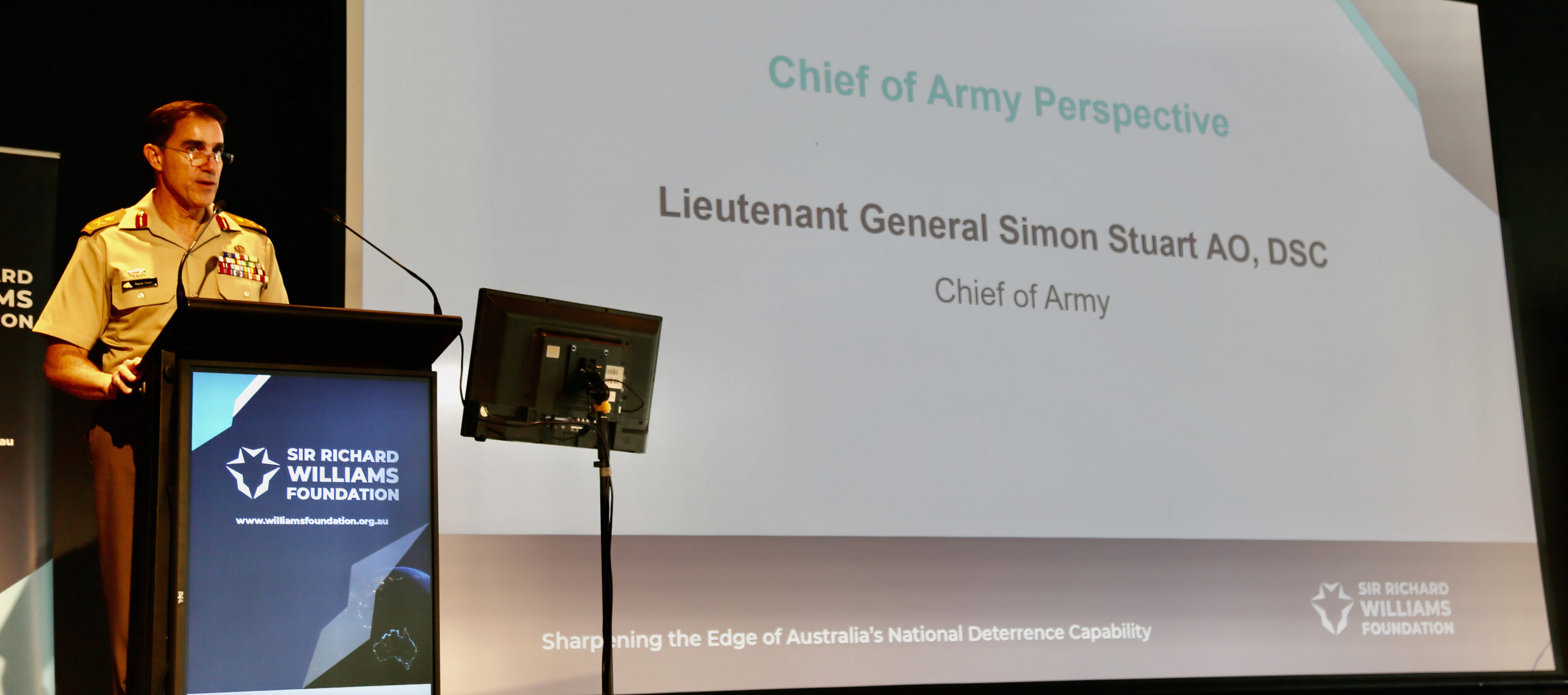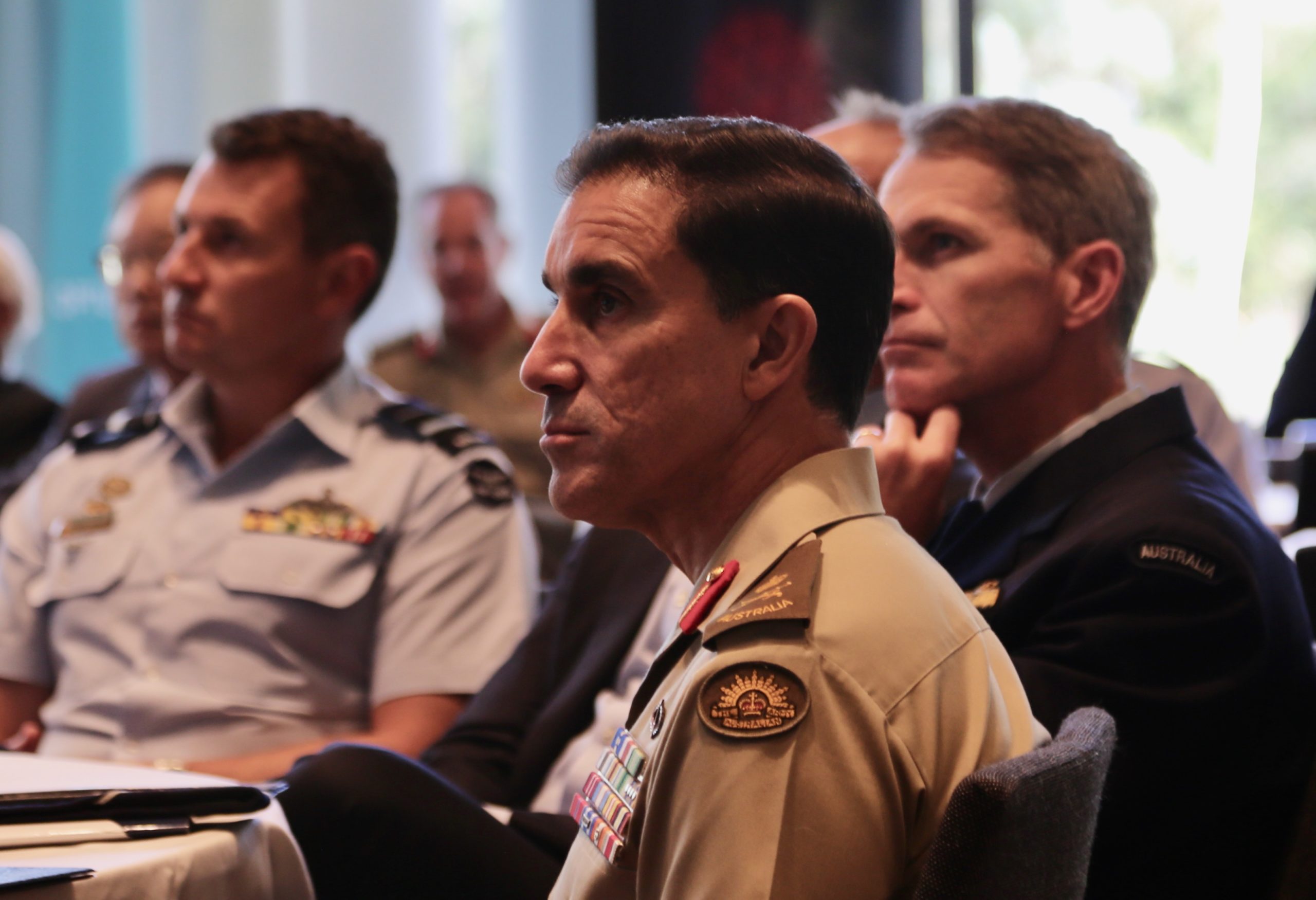With the Australian Army having been heavily invested in the Middle East land wars and working closely with the U.S. Army in those endeavours, what is role in the enhanced emphasis on the direct defense of Australia?
Of course, each of the services and the joint force itself is facing how to meet the challenge of direct defense, but the question of the relationship of the land forces to the joint direct defense of Australia is especially challenging.
At the Williams Foundation Seminar on deterrence, LTGEN Simon Stuart, COS of the Australian Army, provided a general look at the deterrence challenge, the role of the ADF and of the Australian Army.
Although he noted in his speech “that that there is anything uniquely Australian about deterrence as part of our strategy, or indeed how we might practice it. “
But with the emergence of what is often called great power competition, the role of nation has been enhanced and the need to shape national approaches even when interactive with key allies is central to the way ahead for national deterrence.
LTGEN Stuart then addresses the question of an Australian approach from that perspective.
”If there were to be such a thing as a uniquely Australian way of deterring, it would surely be founded by what defines us as a nation and what defines us Australians.
“Who are we as a nation, and who are we as a people in the middle decades of the 21st century?
“A uniquely Australian approach to deterrence would surely be founded in what our national aspirations were, our strategic culture, and approaching the task of deterrence from that perspective. So, the founding question for me is: how do we conceive of and combine our amazing national endowment?
“Our enviable strategic geography, our stewardship of a significant proportion of the Earth’s surface – both the land mass and the seas that we are responsible for, and over 40 per cent of the Antarctic continent, which we lay claim to.
“We are among the world’s top 15 economies, we have convening power both regionally and globally, we have a vibrant and diverse successful social experiment in our society today, our amazing human capital, and we have a series and a set of alliances and partnerships which are the envy of many.
“We have the capacity to be a global energy and food superpower.
“We have incredible natural resources, both those that have been in demand up until now, and those that will be in demand in the future. And the capacity to draw on 65,000 years of human history and endeavour on our continent.

“So how can we conceive of that wonderful endowment, and how do we conceive bringing it together?
“Are we outwardly focused and engaged, or are we insular and closed?
“And, for everyone who wears or has worn our uniform today – and certainly for every Australian soldier – the answer to the question ‘who are we?’ is of fundamental importance to service.
“Because we need to understand for whom and for what we are serving. And if we are in the fight, those questions are brought into even sharper relief.
LTGEN Stuart then addressed the key question of the nature of the new strategic context within which Australia or other liberal democracies are now operating.
“Pax-Americana was an historic anomaly. The norm in human history is a violent transfer of power from one empire to another – and 14 of the 16 transitions between empires in human history have involved wars.
“We live in an era that might be described as post-peak globalisation. Understanding how the international system works, what the great economic or trading blocks are, is an endeavour we need to understand.
“There are a range of theories, but personally I like Parag Khanna’s new regionalism model because it emphasises partnerships, and partnerships within the context of regional blocks from an economic perspective – but also from the other elements of national power, which are in the ascendancy in the global system today.
“To some of our more recent history and the thinking from the 1980s that shaped our national security and defence policy, strategy and practice over the last 30 years.
“The thinking that we do today, and the decisions that our elected representatives make today, will influence our policy and practice over the next few decades.
“That thinking, in my view, failed to engage with the world as it was, failed to engage with globalisation, either refused to engage or didn’t recognise pretty much everything we’ve actually been doing these past few decades.
“It was defensive and inward looking.
“And finally, the wars we’ve been involved in, the wars we’ve been fighting over the last 20 years, the so-called ‘wars of choice’, did not touch Australia and did not touch Australians.
“They were a Defence endeavour, involving only the military element of our national power, and largely an ADF endeavour. They did not touch the society we live in.”
What then shapes a way ahead for the ADF in this new historical era is the importance of being embedded in a broader national approach requiring skill sets beyond those expected of the military
LTGEN Stuart the addressed some of these broader capabilities.
“How does our national aspiration and our national identity find expression in our strategic thinking and our policy and practice. It finds expression via statecraft, which is the mobilisation and orchestration of all elements of national power.
And the key areas of focus are that people like us need to help our elected representatives deal with are founded in national identity, and national unity, and therefore the wellspring of unity and purpose.
“It relies on social cohesion, it relies on the means by which to execute the strategy – that is our economy – the means connote and provide agency for us as a nation.
“It will rely on an involved relationship between the private and public sector, on better harnessing the incredible capacity of our academy.
“It will rely on the practice of statecraft on a more expansive engagement with partners and the development of partnerships.”
LTGEN Stuart finally focused on the military element of deterrence. “The military element of national power needs to be four things. Firstly, it needs to reflect our national identity and aspiration.
“It needs to reflect the nature of the challenges, the threats and the competition. And it needs to reflect the nature of our strategy, which in its broadest terms is shape, deter and respond.
“It needs to respect the arc of human history, and the history of warfare, and respect the requirement to balance between the enduring human nature of warfare and its changing character – which is generally speaking dominated by technology.
It needs to ensure relevance – relevance and credibility that are relative to a pacing threat, and an operating environment, and the opinions of our allies and partners.
“It also needs to be resourced, because a strategy without means is an illusion.
“So our strategy today calls on us to shape the environment, deter actions against our interests, and be ready to respond with military force in all five domains when required.
“But shape, deter and respond does not connote a linear progression or the luxury of focusing on one at the expense of others.
“It is all three, all at once and in five domains, in the context of the execution and application of statecraft.
“If deterrence fails, war and its very unpredictability demands an ADF that is relevant and credible in all five domains – a system of systems that has the best chance of mission success whether we are deterring or we are prevailing in the conquest of war.
“To come back to the point about strategy being an illusion is it is not resourced, there are key questions that are being asked today in our nation.
“We have a pretty good sense of what it costs. There is a sharp focus on what we can afford, and then there are choices about what we are willing to pay.
“Each of those price points brings with it a risk profile, and those are the difficult decisions that our government needs to make.
“Those are difficult decisions to which we need to contribute the best advice that we possibly can.”
LTGEN Stuart then focused on the way ahead for the ADF and the Army.
“Given the nature of our strategic circumstances, whatever we do requires us to do it quickly. Velocity matters.
“One way we can sharpen the edge of deterrence is by embracing new and emerging technologies and balancing that with the incredible human capital we enjoy in our country.
“I’m going to quote our Chief of Air Force from his excellence speech, which I commend to you, which he gave as a keynote at the Chief of Air Force Symposium in Melbourne as a precursor to the Avalon Air Show recently.
“He said: “It is easy to be seduced by technology; to do so would be to forget that national security is a national endeavour.
“The impediments to boosting capability delivery are often policy related, procedural or cultural. While advanced platforms teamed with cutting edge and disruptive technologies can be game-changes, we won’t realise their advantage without evolving our thinking that delivers the military power element of deterrence.”
“I think for me that really summarised the set of dilemmas and choices we face today in terms of responding to the strategic environment.
“Another way forward is leveraging the existing strengths of our Defence Force by ensuring we have a sharper focus on how we design our force, which is integrated and greater than the sum of our constituent parts.
“One that is increasingly builds into the architecture a strong and abiding sense of partnership with allies and regional partners.
“Because in an era of great power competition, having more friends is better than having less.
“In our region we have very good relationships with our partners. And the people to people relationships we enjoy have been grown and cultivated and reinforced over many, many years and stand us well for the future.
“Shared interests matter, and the many collective agreements like AUKUS and like FPDA and the Quad, and like the support we have of the ASEAN political architecture matter and stand us in good stead for tomorrow.
“From an Army perspective, from the contribution of land power to that integrated force, we offer presence, persistence, asymmetry through first-mover advantage, utility, and incredibly good value for money.”
I would add that I believe there a number of ways the land forces can play an important role in the direct defense of Australia and will identify some thoughts in future pieces.


